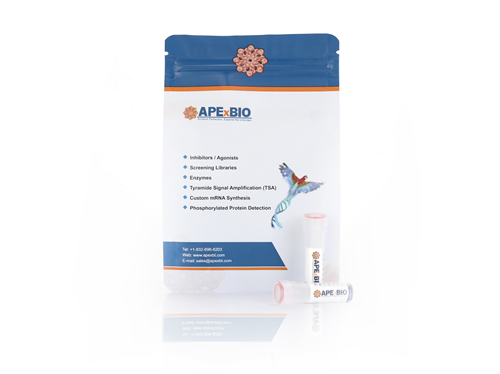Recombinant Mouse IL-19 (His, Flag)
Interleukin 19 (IL-19) is a member of the IL-10 family of cytokines [1]. The IL-10 family is a class II alpha -helical collection of cytokines that contains two groups, a viral homolog and a cellular homolog group. Within the cellular homolog group, there are two additional groupings, one which uses IL-10 R2 as a signal transducing receptor (IL-10, IL-22 and IL-26), and one which uses IL-20 R2 as a signal transducing receptor (IL-19, IL-20 and IL-24) [2 - 4]. Mouse IL-19 is synthesized as a 176 amino acid (aa) precursor that contains a 24 aa signal sequence and a 152 aa mature region [5]. Based on human studies, it is expected to be secreted as a glycosylated monomer, 35 - 45 kDa in size [2, 6, 7]. IL-19 is unusual in that it contains seven amphipathic helices [2, 4, 8]. Mature mouse IL-19 shares 69% aa sequence identity with the mature human IL-19, and 85% and 68% aa identity to unpublished Genbank sequences for rat and canine IL-19, respectively. Although mouse IL-19 is active on human cells, human IL-19 is not active on mouse cells [5]. IL-19 expression is limited to activated keratinocytes and monocytes, with a possible contribution from B cells [6, 9, 10]. IL-19 binds a receptor complex consisting of the IL-20 receptor alpha (also known as IL-20 R1) and the IL-20 receptor beta (IL-20 R2) [3, 4, 11, 12]. This receptor complex is also shared by IL-20 and IL-24. Notably, IL-19 is reported to actually bind to IL-20 R2, which is generally considered to be only the signal transducing receptor subunit [7, 13]. Functionally, it has been reported that IL-19 both will and will not induce IL-6 and TNF production by monocytes [5, 14]. It does, however, seem to drive T-helper cell differentiation towards a Th2 response, inducing both IL-10 and production of itself [5, 14].
Reference
[1]. Fickenscher, H. et al. (2002) Trends Immunol. 23:89.
[2]. Pestka, S. et al. (2004) Annu. Rev. Immunol. 22:929.
[3]. Zdanov, (2004) Curr. Pharm. Des. 10:3873.
[4]. Gallagher, G. et al. (2004) Int. Immunopathol. 4:615.
[5]. Laio, Y.-C. et al. (2002) J. Immunol. 169:4288.
[6]. Gallagher, G. et al. (2000) Genes Immun. 1:442.
[7]. Pletnev, S. et al. (2003) Biochemistry 42:12617.
[8]. Chang, C. et al. (2003) J. Biol. Chem. 278:3308.
[9]. Romer, J. et al. (2003) J. Invest. Dermatol. 121:1306.
[10]. Wolk, K. et al. (2002) J. Immunol. 168:5397.
[11]. Dumoutier, L. et al. (2001) J. Immunol. 167:3545.
[12]. Parrish-Novak, J. et al. (2002) J. Biol. Chem. 277:47517
[13]. Preimel, D. and H. Sticht (2004) J. Mol. Model. 10:290.
[14]. Jordan, W.J. et al. (2005) Eur. J. Immunol. 35:1576
| Gene ID | 329244 |
| Accession # | Q8CJ70 |
| Alternate Names | IL-10C; IL19; IL-19; interleukin 19; MDA1; melanoma differentiation associated protein-like protein |
| Source | HEK293 |
| Protein sequence | LRRCLISVDMRLIEKSFHEIKRAMQTKDTFKNVTILSLENLRSIKPGDVCCMTNNLLTFYRDRVFQDHQERSLEVLRRISSIANSFLCVQKSLERCQVHRQCNCSQEATNATRIIHDNYNQLEVSSAALKSLGELNILLAWIDRNHLETPAA |
| M.Wt | The protein has a calculated MW of 21.82 kDa. |
| Appearance | Solution protein |
| Stability & Storage | Use a manual defrost freezer and avoid repeated freeze-thaw cycles - 36 months from date of receipt, -20 to -70°C as supplied |
| Concentration | 1 mg/mL |
| Formulation | Supplied as a 0.2 μm filtered solution in PBS, pH7.4. |
| Reconstitution | We recommend that this vial be briefly centrifuged prior to opening to bring the contents to the bottom. This solution can be diluted into other aqueous buffers. |
| Biological Activity | Fully biologically active as determined by a cell proliferation assay using BaF3 mouse pro‑B cells transfected with human IL-20 Rα and human IL-20 Rβ cells. The EC50 for this effect is 4.8 ng/mL. |
| Shipping Condition | Shipping with dry ice. |
| Handling | Centrifuge the vial prior to opening. |
| Usage | For Research Use Only! Not to be used in humans. |
Quality Control & DataSheet
- View current batch:
-
Purity > 95 % by SDS-PAGE
- Datasheet
Endotoxin: Less than 1.0 EU/µg as determined by LAL method.








